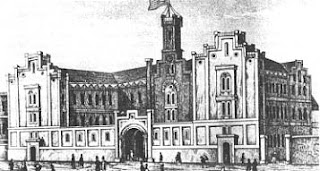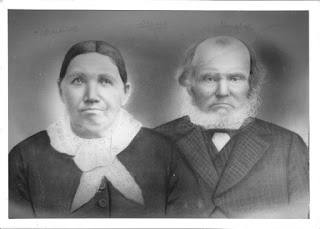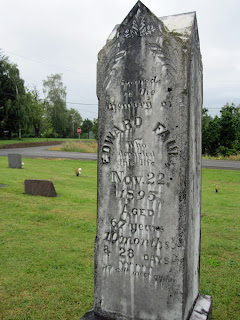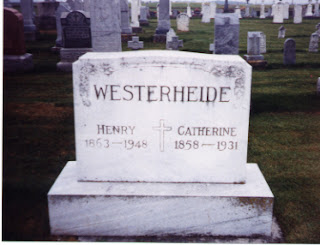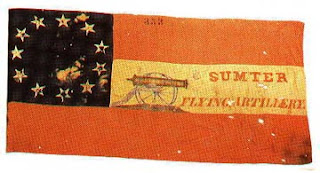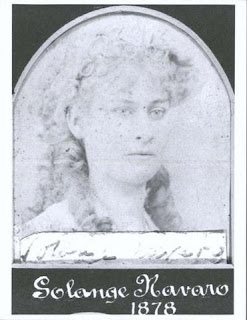Edward Francis Westerheide, my great-grand uncle, was born on a farm near Egypt, Auglaize County, Ohio on November 18, 1887. He was the first child of Henry Westerheide and his wife Catherine Bornhorst (I wrote about Catherine previously here). Edward's siblings were Julius Henry (1889-1963), Mary (1891-1949), George (1893-1926), Raymond Bernard - my great grandfather (1894-1981), Pauline (1896-1977), Joseph Ignatius (1897-1976), Anthony Frederick (1899-1963), and Henry A (1902-1985). He also had several step brothers and sisters from his mother's first marriage. They were Emma Catherine Severin (1877-1935), Anne Severin (1878-??), Franz Joseph Severin (1880-1931), and Bernard Severin (??-??).
Ida's parents were John Laufersweiler and Anna Schmuecker. The Laufersweiler family was well known in the area. John Laufersweiler began his career as a canal boat driver on the Miami & Erie Canal. At age 16 he drove the mail stage between New Bremen and Piqua and later learned the tinner's trade, purchased an interest in a local business and eventually became the sole proprietor of that business. He served as clerk of the village of Minster for eight years and as treasurer for four years. He was a stockholder of the Minster Bank and Jackson Gas & Oil Company and he served as secretary of the Minster Loan & Savings Company for many years as well as owning his own hardware store. Both John and Anna died the same year that Edward and Ida were married, in 1913. She died on May 10th while he died on October 14th. One of John's nieces, Mary Genevieve Laufersweiler, married Agustus Halvorsen Hilton, and their great-great granddaughter is well known around the world as Paris Whitney Hilton.
As a veterinarian, Edward worked predominantly with farm animals and witnessed many interesting and peculiar cases. One case, which he found interesting enough to submit to the Journal of Veterinary Medicine in 1914 went as follows:
I had a peculiar case of impaction in a cow. I was called January 14th, 1914, to see a cow at a farm eight miles from the office. The owner informed me that she had given birth to a nice calf about two weeks previous, and had continued in good health until the morning of the same day.
I was called at 9:30 p.m. She had a milk flow of seven gallons per day up till the morning of January 13th, when it had dropped to two gallons. After an examination of the cow, I concluded to give one and one-half pounds magnesium sulphate with one dram of fluidextract of nux vomica four times a day. On the morning of the 15th the owner telephoned that he thought she hadn't cleaned herself, and that a piece of the fetal membrane was protruding.
Upon my arrival at the farm I noticed that the supposed membrane was a loop of small intestine protruding from the rectum. I took hold of it and commenced cleaning the parts, when it gradually started to move with a passage from the cow and nearly ten feet were in the bosin. I told the owner to hold the first loop in. I then discovered it was the intestine from a hog, and upon so informing the farmer, he told me that his cows had had access to a pasture field nearly two months before where he had burned (partially) 22 hogs which had died of hog cholera, but declared that none of the cows in the herd of 25 had had access to the pasture for two months, so undoubtedly the cow carried twenty-five feet of hog intestine in her bowels for two months. She fully recovered in three days' time to her normal flow of milk and the owner was well satisfied to save his best cow.
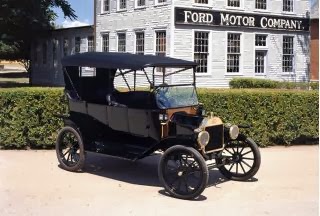 Edward and Ida had six children; John R (1913-1913), Ruth Alice (1915-1996), Elizabeth Jane (1916-1979), Dr. Francis Xavier (1920--), John Thomas (1922-1994), and Allen E (1924-1984). Dr. Westerheide was a practicing veterinarian for almost 40 years and retired from his veterinary business in 1950 due to heart problems. In 1914 Dr. Westerheide was one of the first people to open a Ford automobile dealership. He was selling the Ford Model T at that time and held onto the Ford franchise dealership until his death in 1955. One interesting fact about the Westerheide Ford dealership was that they sold the 20 millionth Ford and there is a picture of Henry Ford and Edward Westerheide celebrating that milestone in Ford history.
Edward and Ida had six children; John R (1913-1913), Ruth Alice (1915-1996), Elizabeth Jane (1916-1979), Dr. Francis Xavier (1920--), John Thomas (1922-1994), and Allen E (1924-1984). Dr. Westerheide was a practicing veterinarian for almost 40 years and retired from his veterinary business in 1950 due to heart problems. In 1914 Dr. Westerheide was one of the first people to open a Ford automobile dealership. He was selling the Ford Model T at that time and held onto the Ford franchise dealership until his death in 1955. One interesting fact about the Westerheide Ford dealership was that they sold the 20 millionth Ford and there is a picture of Henry Ford and Edward Westerheide celebrating that milestone in Ford history.
He was very active in civic matters including being associated with the Auglaize County Fair for 25 years, served as director of the Auglaize County Agricultural Society, served 12 years as a member of the Auglaize County Democratic Central and Executives committees, vice president of the Roosevelt-Davey Club in 1936, and was an active member of the Auglaize County Auto Club. He was the assessor for Jackson Township from 1912 to 1914 and was active on the Lake Loramie Improvement Association and worked for the betterment of Lake Loramie through securing roads and other improvements of the lake area. He also held membership in the Knights of Columbus, Fraternal of Eagles, the Elks Lodge of Wapakoneta, and the Minster Commercial Club. In addition, Dr. Westerheide made frequent trips to the Ford Motor Company in Detroit, Michigan and also frequented Columbus, Ohio where he lobbied for road construction and transportation related programs.
The Westerheide family established their home on North Frankfort Street in 1917 when they purchased the former residence of Mrs. Minnie Goeke. In 1920, Edward and Ida, along with their daughters Ruth Alice and Elizabeth Jane were living on Frankfort Street. Also living in their home were two of Ida's brothers, William Henry and John William Laufersweiler, aged 16 and 19 respectively. These two brothers may have moved in with the family soon after their parents died in 1913. The Westerheide family were still living at 124 N. Frankfort Street in 1930 along with their children; Ruth Alice, Betty Jane, James, John and Allen. August of 1937 was a busy month for Dr. Westerheide and his family. Early in the month their daughter Ruth was visiting them from Tulsa, Oklahoma. The next week Dr. Westerheide met as a representative for the Fourth District leaders to discuss the election of Governor Davey. Then a week later John became ill and the family spent several days in Detroit consulting with specialists at the Ford Hospital. From what I can see in the social news of the day, this is probably a typical schedule for this family. In 1940 the family was still living on Frankfort Street and consisted of Edward, his wife Ida and their two sons, John and Allen, both of which are attending school.
On October 1, 1955, at the age of 67, Dr. E. F. Westerheide died of a heart attack. He had been in failing health for a long period and became ill two weeks before his death. His condition became critical about 9:00 p.m. and he died a little after midnight. His wife, Ida Laufersweiler, died four years later, on November 13, 1959, age 73. They are buried side-by-side in St. Augustines Cemetery in Minster, Ohio.


